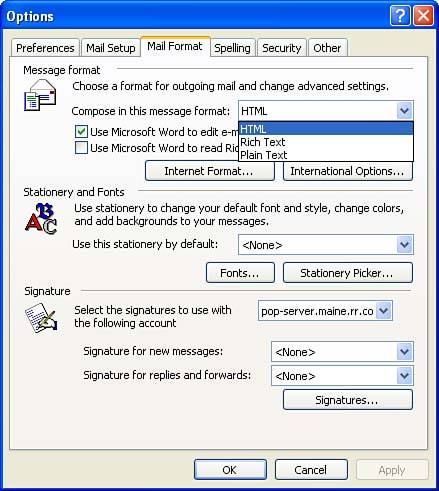| The default message format in Outlook is HTML. If you send most of your messages to individuals who don't have mail clients that can read the HTML format, you might want to change the default to plain text. On corporate networks, you might find an advantage to using the Rich Text Format as the default text format for your messages. This file format was developed for the Exchange Server mail environment used on many business networks. The default format is set in the Outlook Options dialog box on the Mail Format tab. Fortunately, Outlook makes it very easy for you to switch the format of a mail message while you are composing the message. First, let's take a look at how to set the default mail type, and then look at how to change the message format while composing the message. To set the default message format: -
Click Tools, Options . The Options dialog box appears. -
Click the Mail Format tab (see Figure 4.4). Figure 4.4. You can send your messages in HTML, Rich Text Format, or plain-text format.   | Include Hyperlinks If you use the HTML or Rich Text Format message formats, you can include hyperlinks in your e- mails . Hyperlinks are Web addresses and e-mail addresses that can be accessed by clicking them in the message. Just type the Web address or e-mail address, and the hyperlink is created automatically in the message. |
-
To select the message format, click the Compose in This Message Format drop-down box. Select HTML, Rich Text , or Plain Text . If you want to use Microsoft Word as your e-mail editor, click the Use Microsoft Word to Edit E-mail Messages check box (if it is not already selected).  | Using HTML Stationery If you use the HTML format for your messages, you can also select to use a particular stationery on the Mail Format tab. Stationery types can be previewed using the Stationery Picker button. Be advised that HTML stationery will slow down the loading of e-mail messages on the recipient's computer, and not everyone will have a mail client that can view the stationery. You probably should use the stationery only for personal messages to friends and family members who also use Outlook as their e-mail client. |
|
